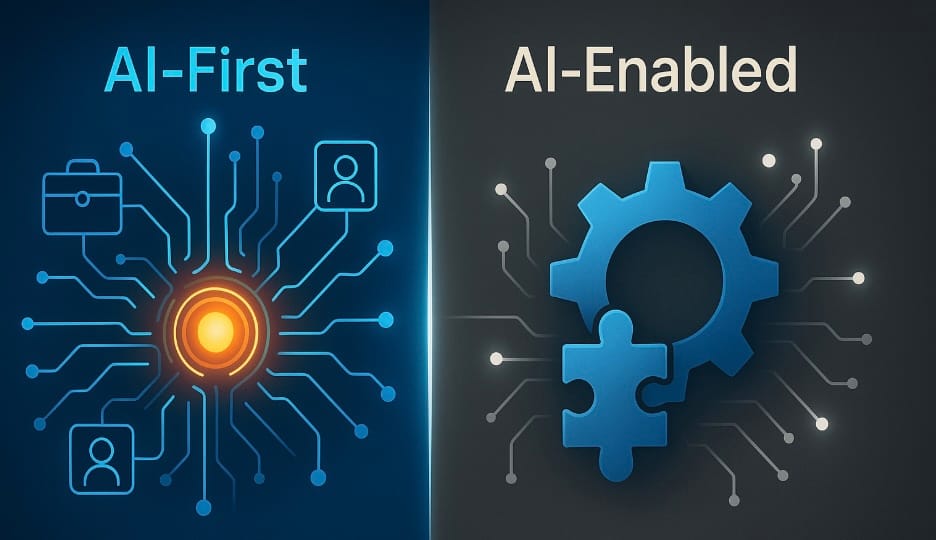AI-First vs. AI-Enabled: Why Your Choice Defines Your Future

1. Why Everyone's Suddenly Talking "AI-First"
In recent weeks, CEOs from Box, Shopify, and Duolingo published strikingly similar "AI-first" memos. But beneath the buzzwords, they're mostly describing incremental evolution, not radical reinvention:
- Box: CEO Aaron Levie asked his team, "What would our work look like if we started fresh in 2025?"
- Shopify: CEO Tobi Lütke set AI as a new baseline, freezing headcount unless teams show AI can’t do the job.
- Duolingo: CEO Luis von Ahn tied hiring and performance directly to AI adoption, warning minor adjustments aren’t enough.
Their language says "AI-first," but their approach remains cautiously "AI-enabled."
2. AI-First vs. AI-Enabled: What’s the Real Difference?
| AI-First Businesses | AI-Enabled Businesses |
|---|---|
| AI is fundamental; products cannot exist without it. | AI enhances existing products and processes. |
| Teams built specifically around AI capabilities and continuous experimentation. | Existing teams adopt AI to boost efficiency. |
| Examples: Perplexity, built entirely around AI-driven search. | Examples: Google adding generative snippets alongside traditional search results. |
While most established companies (like Box, Shopify, Duolingo) comfortably take the AI-enabled route, experts consistently caution that incremental AI improvements alone rarely bridge the gap against companies born AI-first:
- McKinsey: Genuine AI-first strategy means rebuilding your business around AI.
- Harvard Business Review: Incremental AI pilots often prevent deeper, strategic innovation.
- Boston Consulting Group: Only 25% of businesses successfully move beyond simple efficiency gains to fully transform their market.
3. Why Settling for AI-Enabled is Risky
Incremental AI enhancements feel safe—but they might not protect your future competitiveness:
- Speed: AI-first startups (like Perplexity or Replit) make rapid product changes, turning days into significant leaps.
- Profitability: McKinsey found companies fully reworking workflows with AI are 3x more likely to increase profits.
- Defensibility: Intuit’s new AI-native financial platform (GenOS) is creating entirely new revenue streams impossible through incremental changes to QuickBooks.
Simply put, evolution feels comfortable but offers limited defense when competitors have reshaped your entire category with AI-first strategies.
4. Going Truly AI-First: What's Actually Required?
Taking an AI-first path involves bold strategic shifts:
- Redesign Products: Build or deeply refactor around core AI models and real-time data.
- Restructure Teams: Shift from traditional functional teams to cross-functional "AI pods".
- Create Proprietary Advantages: Invest in domain-specific data and fine-tuned AI models difficult for competitors to replicate.
- Be Willing to Cannibalize: Let go of profitable but outdated features holding back AI innovation.
Most large companies struggle to make these radical moves without hurting short-term results. This opens opportunities for agile startups and independent consultants to lead meaningful change.
5. How Imbila Helps You Navigate This Shift
At Imbila, we equip consultants and entrepreneurs to decide strategically:
- Enhance: Introduce AI tools to boost existing workflows quickly.
- Rebuild: Create experimental teams to develop AI-native offerings while sustaining legacy businesses.
- Invent: Run zero-to-one workshops to ideate entirely new products that leverage ubiquitous, affordable AI.
Whether you're transforming a traditional business or launching a new venture, clearly defining your AI strategy is critical. AI-enabled might keep you competitive today—but AI-first could define your survival tomorrow.
Ready to shape your future intentionally? Join Imbila, and let's build tomorrow's success together.

